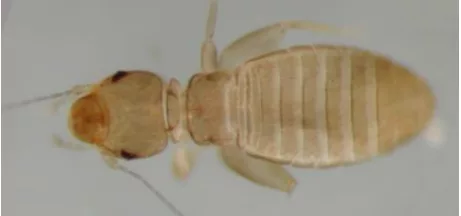Sponsored Content
How to Identify, Prevent, and Remove Psocids from Food Processing Facilities

When it comes to food processing pest management, some threats are more obvious than others. Signs of common pests—such as rodents, flies, and cockroaches—are usually hard to miss. Pests unique to the food processing and distribution industry, known as stored product pests, pose their own distinct challenges. One of these pests, the psocid, is particularly difficult to manage.
Food processing facilities can experience psocids as contaminants in or on ingredients and packaging, but these pests can also quickly eat through your profits if left unmanaged. In large numbers, psocids can contaminate sizable amounts of product, especially when left in storage. They can lead to tainting of ingredients and potentially alter the taste of products.
Part of what makes psocids so difficult to identify and manage is their nearly microscopic size. Psocids typically measure only one millimeter in length, appearing as tiny dots to the naked, untrained eye. Inspectors, however, know where to find them and frequently do. While you might not recognize a psocid problem, your auditor surely will. To avoid learning about psocid activity in your facility from your auditor, you first need to know how to identify these minute pests.
Identifying Psocids
Psocids, also known as booklice or barklice, range in color from white to brown or grey. While only one millimeter in length, their body measures three times longer than wide, giving them an elongated, flattened appearance. Atop their head, psocids have long, thread-like antennae. Their head oftentimes looks too large for their body, with its widest point just before the start of their abdomen. Some species of psocids have wings that cover their abdomen at an angle, forming a roof.
Sightings of psocids can range from noticing a few isolated individuals to discovering millions coating surfaces. Once sighted, psocid treatment for a facility begins with identifying that psocids are present. Psocids have different life-stage characteristics that can require knowledge of what life stages are present and if there is a mixture of winged and non-winged individuals. Food processing facilities encounter eight common species, and food processing infestations can involve more than one species.
The reproductive habits of psocids further add to the challenge. Psocids develop from egg to adult in as few as 18 days. And since adults can live up to 3 months, psocids can reproduce often, quickly, and for a significant period of time, allowing their populations to multiply rapidly. Certain species of psocids have an additional advantage. At least two species, Liposcelis bostrychophila and Lepinotus reticulatus, can reproduce parthenogenetically, meaning without the presence of a male, increasing birthrates further. The presence of a few psocids can rapidly increase to an infestation, unless dealt with efficiently and immediately.
Preventing Psocids
Fortunately, preventive measures for psocids can begin in-house, once you know what to look for. Effective prevention methods help reduce or even eliminate conducive conditions. Conducive conditions are elements of the facility’s environment that attract pests, and for psocids, this includes high humidity and sanitation issues.
Looking for quick answers on food safety topics?
Try Ask FSM, our new smart AI search tool.
Ask FSM →
Psocids thrive in humid environments, since one of their preferred food sources is mold spores. Facilities located in climates with routine or occasional humid weather should inspect for psocids during the humid stretches of time. Packing supplies stored in poorly ventilated, humid areas are especially vulnerable to psocid activity. To help alleviate high humidity, facilities should consider adding environmental controls and preventing moisture when possible. The classic recommendations to correct higher moisture levels include portable heaters, fans, dehumidifiers, and other means to move air and promote drying of humidity or dampness. Prevent added humidity further by avoiding wood pallets, which tend to hold moisture.
Psocids feed primarily on organic matter such as molds, fungi, and algae, but will also feed on starch-based materials such as grains and glues. Dust is another known harborage for psocids, since molds and other food sources can occur with these. Psocid activity behind storage racks can occur, since air movement is limited, allowing higher humidity, dust, and molds to accumulate. Facilities should store products to avoid dust buildup, placing the most susceptible supplies or products above floor level on racks where air circulation will be best. Regularly inspecting bags and packages containing starchy products can also help prevent psocid activity.
Involving Your Provider
While in-house efforts can help keep additional pests from entering, it’s best to involve your pest management professional to address conductive conditions or any existing infestations.
Though there’s limited knowledge on the effectiveness of certain psocid treatments, some options are more likely to succeed than others. Temperature control, humidity control, organophosphates, and some grain protectants are some of the more effective psocid management strategies.
While optimum temperatures for psocid development range in the 80s and 90s, their susceptibility to heat mortality increases in the 100 °F to 140° F range, depending on the species, making heat control a potential treatment tool. Applying temperatures over 104 °F can stunt the development of psocids, helping put an end to population expansion.
Based on the psocids species at hand, and the location and extent of the infestation, your pest management provider will consider the specific needs of your facility and develop an effective strategy for control. Since psocids offer a unique challenge in pest management, don’t hesitate to call on a provider you can trust. With the help of your pest management provider, your facility can be psocid-free.
Learn more about managing psocids in food processing and distribution from Industrial Fumigant Company (IFC)’s experts here.








